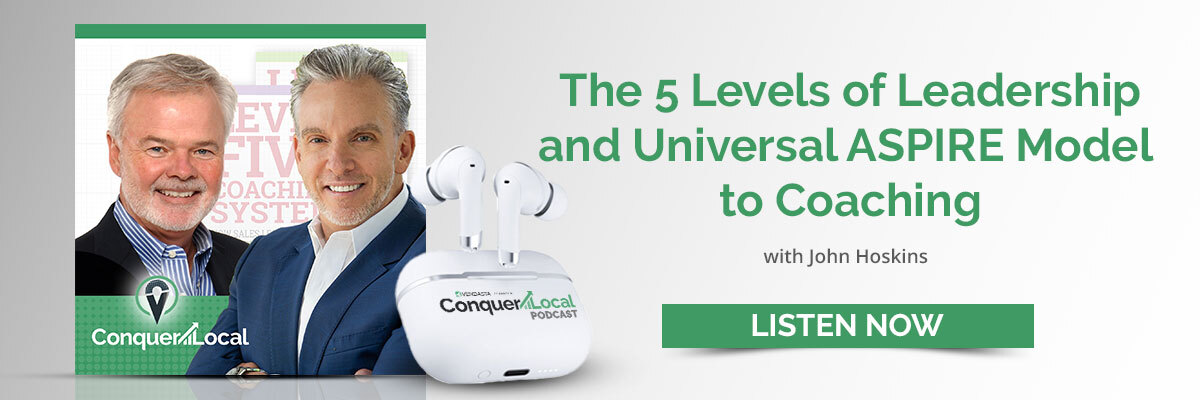The 5 Levels of Leadership and Universal “ASPIRE” Model to Coaching
This blog is a guest article by John Hoskins, author of the Level Five trilogy including Level Five Coaching System and founder of Level Five Selling, LLC.
More than 50 percent of sales representatives who are promoted into sales leadership positions end up failing as a leader. People don’t quit companies, they quit managers, and you see this time and time again in sales organizations.
I’ve focused my career on sales leadership, and I can say with confidence that there are no bad salespeople, only struggling sales managers. It takes a very different set of skills to be a great sales leader versus being a great sales professional. However, these skills are transferable and people are coachable. We developed a universal coaching model called ASPIRE to help sales leaders work with their teams:
Accomplish. Situation. Problems. Ideas. Realism. Execute.
Our goal is to guide sales leaders along their coaching journey from determining the type of leader they are, to become a level five leader. Then we apply the universal coaching model to their sales organization at an individual level so that every salesperson has the tools they need to be successful.
At Level Five Selling, we developed the five levels of leadership to help sales leaders visualize the differences between coaching types. The fifth level is where we want all coaches to be in the end. In order to get there, it’s important to understand and recognize the qualities of the other levels beneath it.
Level 1: Buddy
The buddy leader has a tendency to play favorites. This may work initially, but over time this doesn’t work for the team and they will resent their leader. Being a leader is not a popularity contest and it’s not about being well-liked by your team. It goes deeper than that. Admiration does not equal respect.
Level 2: Parent
This leader has learned that being the buddy doesn’t work. However, at the parent level, they easily overlook their salespersons’ limitations. The parent leader doesn’t give their team the creative freedom to think critically. This confines sales teams and stifles innovation in the process. Constant hand-holding can create a sense of entitlement in the team because they aren’t being challenged by their leader.
Level 3: Boss
This leader has a tendency to follow the “three strikes, you’re out” rule. The “my way or the highway” mentality common with these leaders can look like micromanagement. Teams under this kind of leadership tend to be fearful of losing their job, have high churn, and have little to no passion for their work. The boss-level management style is typically where we see salespeople join a good company but then leave because of bad management.
Level 4: Expert coach
The expert coach is usually someone who tends to be more evaluative rather than developmental. They have the skills, knowledge, and wisdom to successfully mentor salespeople by telling them what to do. This still doesn’t give a sales team the confidence they need to become a well-oiled sales machine. Salespeople under the expert coach leader tend to be less innovative problem-solvers than those under the fifth level of leadership.
Level 5: Partner in performance
This partner level is the holy grail of coaching. The idea of becoming a partner and having your team's back. There is no hierarchy here and the coach passes their wisdom through inquiry instead of telling. The partner in performance helps people self-diagnose so that when the leader is unavailable their team has the confidence and ability to make the best decisions. This leader gains commitment from their team rather than compliance.
Where sales leaders get stuck
The most common level that I see in new leaders is level three: the boss. These are usually the people who get promoted quickly into sales leadership, and unfortunately, they usually aren’t given the training and tools they need to get past level three. Many other sales leaders are stuck at level four, consistently defaulting to telling people how it is instead of working with them.
Universal coaching ASPIRE model
In my work, I have seen that coaching adverse companies have lower productivity and higher turnover. These are symptoms of an organization where coaching isn’t the norm. At Level Five Selling, we’ve built a universal coaching model for leadership. The main benefit of the ASPIRE model is that it’s collaborative. ASPIRE takes salespeople through a problem-solving discussion guided by their sales leader from goal setting to execution. Collaboration = commitment to the work being done and the problem is solved.
A - accomplish
Mutually establish what needs to be accomplished.
S - situation
Why are you thinking how you’re thinking? What are your concerns?
P - problems
What is getting in your way? What can’t you overcome?
I - ideas
Remove solution restrictions and limitations. How can you make the problems go away?
R - realism
What can you do to move toward accomplishing the goal?
E - execute
Have a plan that you can follow. Did you execute?
Sales leadership in coaching
It’s not just sales leaders, salespeople can also be coaches. They might coach a peer, client, or even their boss, so the job of the sales leader is to pass on all of their knowledge to their team. This is why the ASPIRE model is universal, it can be used in so many different situations, even coaching your own children.
Under a leader who understands the five levels of leadership and teaches their team the ASPIRE coaching framework, anyone can be a coach with the ASPIRE model of coaching. We use this model with our own sales teams, sales leaders, and executives at Level Five Selling. A key strategy for sales organizations in 2022 should be to create a coaching discipline within your sales organization.
Inspire your team with ASPIRE.


